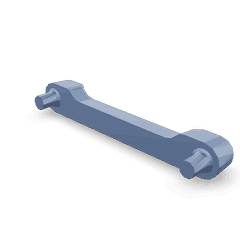Introduction
The Cummins 4918320 Protective Plug is a component designed for use in commercial trucks. Its purpose is to safeguard specific areas of the truck’s system from contaminants and potential damage. This part plays a role in maintaining the integrity and efficiency of the truck’s operations by ensuring that sensitive components remain protected during various driving conditions 1.
Basic Concepts of Protective Plugs
Protective plugs are devices used in automotive systems to block openings that could be vulnerable to the ingress of dirt, moisture, and other contaminants. They function by providing a seal that prevents external elements from entering sensitive parts of the vehicle’s systems. These plugs are commonly applied in areas where components are exposed to the environment but must remain sealed to operate correctly 2.
Purpose and Function of the 4918320 Protective Plug
The Cummins 4918320 Protective Plug is specifically designed to fit into designated ports within a truck’s system. Its role is to seal these ports, thereby protecting internal components from environmental contaminants. The plug is typically placed in areas where the system requires a temporary seal during manufacturing, testing, or when certain components are not in use. This ensures that the system remains clean and functional, contributing to the overall reliability of the truck 3.
Key Features
The Cummins 4918320 Protective Plug is characterized by its robust material composition, which is designed to withstand the harsh conditions often encountered in commercial trucking. It features a precise design that allows for a secure fit within the designated ports. Additionally, the plug may include unique attributes such as anti-corrosive coatings or specialized shapes that enhance its sealing capabilities and durability 4.
Benefits
Utilizing the Cummins 4918320 Protective Plug offers several advantages. It provides effective protection against contaminants, which helps maintain the cleanliness and functionality of the truck’s system. The plug’s durable construction ensures long-term reliability, even under demanding conditions. Furthermore, its design facilitates ease of installation, allowing for quick and efficient sealing of the ports when needed.
Troubleshooting and Maintenance
Common issues with protective plugs may include wear and tear, loss of the plug, or contamination around the seal. Troubleshooting these issues involves inspecting the plug for damage, ensuring it is correctly seated, and cleaning the area around the port to maintain a proper seal. Regular maintenance practices, such as checking the condition of the plug during routine inspections, can help ensure its longevity and proper function.
About Cummins
Cummins Inc. is a global power leader that designs, manufactures, and distributes engines, filtration, and power generation products. With a history spanning over a century, Cummins has established a reputation for quality and innovation in the commercial truck industry. The company is committed to providing reliable and efficient solutions that meet the demanding needs of its customers.
Role of the 4918320 Protective Plug in Engine Systems
This Cummins part is an essential component in various engine systems, providing a barrier against contaminants and ensuring the integrity of sensitive components.
In fuel systems, the protective plug safeguards fuel injectors and fuel rails from dirt, debris, and moisture. This protection is vital for maintaining fuel system efficiency and preventing potential damage to injectors and other components.
Within the engine’s lubrication system, the protective plug is used to shield oil filters and oil galleries. By preventing contaminants from entering the oil system, it helps maintain clean oil flow, which is essential for reducing wear on moving parts and ensuring the longevity of the engine.
In the cooling system, the protective plug is employed to protect radiators and coolant passages. This helps in maintaining the efficiency of heat dissipation and prevents the buildup of contaminants that could clog the system.
For electrical systems, the protective plug is utilized to cover unused wiring harness connectors. This prevents moisture and debris from entering the electrical system, which could lead to short circuits or corrosion.
In emission control systems, the protective plug is used to seal off unused ports and passages. This ensures that the emission control system operates efficiently by preventing the ingress of contaminants that could interfere with the system’s performance.
Overall, the 4918320 protective plug plays a significant role in maintaining the performance and reliability of various engine systems by providing a simple yet effective barrier against environmental contaminants.
Conclusion
The Cummins 4918320 Protective Plug is a vital component in the maintenance and operation of commercial trucks. By providing a robust seal against contaminants, this part ensures the longevity and efficiency of the truck’s systems. Its durable construction and precise design make it an essential element in protecting sensitive components from environmental damage, contributing to the overall reliability and performance of the vehicle.
-
Boyce, Meherwan P. Gas Turbine Engineering Handbook 4th Edition. Butterworth-Heinemann, 2011.
↩ -
Schneider, Wolf-Henning. Pistons and Engine Testing. Springer Nature, 2016.
↩ -
Limpert, Rudolf. Brake Design and Safety, Third Edition. SAE International, 2011.
↩ -
Arora, Shashank, Alireza Tashakori Abkenar, and Shantha Gamini Jayasi. Heavyduty Electric Vehicles: From Concept to Reality. Elsevier, 2021.
↩
SPECIFICATIONS
RECOMMENDED PARTS
* Variable geometry turbocharger and electronic actuator repairs are not eligible to be claimed as over-the-counter under New or ReCon parts warranty for parts installed after October 1, 2018.
* Diesel Oxidation Catalyst (DOC), Diesel Particulate Filter (DPF), Selective Catalyst Reduction (SCR) catalyst, and Electronic Control Module (ECM) repairs are not eligible to be claimed as over-the-counter under New or ReCon parts warranty for parts installed after January 1, 2020.
* These restrictions are only applicable to New parts and ReCon parts coverages for the components listed above sold to a customer in the US or Canada. All other coverages are excluded. All other regions are excluded.









